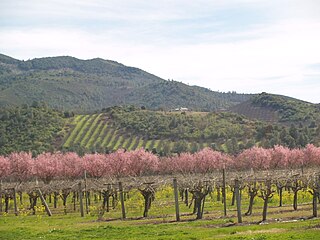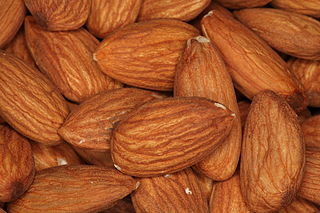
Terroir is a French term used to describe the environmental factors that affect a crop's phenotype, including unique environment contexts, farming practices and a crop's specific growth habitat. Collectively, these contextual characteristics are said to have a character; terroir also refers to this character.
Biodynamic wines are wines made employing the biodynamic methods both to grow the fruit and during the post-harvest processing. Biodynamic wine production uses organic farming methods while also employing soil supplements prepared according to Rudolf Steiner's formulas, following a planting calendar that depends upon astrological configurations, and treating the earth as "a living and receptive organism."

Vitis californica, with common names California wild grape, Northern California grape, and Pacific grape, is a wild grape species widespread across much of California as well as southwestern Oregon.

Mission grapes are a variety of Vitis vinifera introduced from Spain to the western coasts of North and South America by Catholic New World missionaries for use in making sacramental, table, and fortified wines. It is grown in South America, particularly in Chile and Peru, under then names Criolla and Pais. During the 19th century, the grape was known by several other names, including the Los Angeles grape, and the California grape.

Sagrantino is an Italian grape variety that is indigenous to the region of Umbria in Central Italy. It is grown primarily in the village of Montefalco and the surrounding area, with a recent rapid increase in planting area from 351 hectares in 2000 to 994 hectares by 2010 dedicated to the grape, in the hands of about 50 producers.
The Winkler Index, sometimes known as the Winkler Scale or WinklerRegions, is a technique for classifying the climate of wine growing regions based on heat summation or growing degree-days. In the system, geographical areas are divided into five climate regions based on temperature converted to growing degree-days, and is commonly known as Regions I–V. The system was developed at the University of California, Davis by A. J. Winkler and Maynard Amerine.

The production of wine in New Jersey has increased significantly in the last thirty years with the opening of new wineries. Beginning in 1981, the state legislature relaxed Prohibition-era restrictions and crafted new laws to facilitate the growth of the industry and provide new opportunities for winery licenses. Today, New Jersey wineries are crafting wines that have earned recognition for their quality from critics, industry leaders, and in national and international competitions. As of 2019, New Jersey currently has 51 licensed and operating wineries with several more prospective wineries in various stages of development.
The Guenoc Valley AVA is an American Viticultural Area in Lake County, California, United States, about 15 mi (24 km) north of the town of Calistoga. Guenoc Valley AVA was the first American Viticultural Area designation granted to an area with just a single winery.

Sonoma County wine is wine made in Sonoma County, California, in the United States.

Lake County wine is an appellation that designates wine made from grapes grown mostly in Lake County, California and located north of Napa County. Although each region within Lake County has unique viticultural attributes, all are influenced by Clear Lake, the largest inland body of water in California. Lake County enjoys a reputation for bright, concentrated red wines made from Cabernet Sauvignon, Syrah and Zinfandel, and fresh, aromatic whites made from Sauvignon Blanc. Cabernet Sauvignon has the most acreage, with Merlot a distant second.

Ironstone Vineyards is a winery that is noted for the production of several leading US wine brands, including Obsession Wines, Leaping Horse Vineyards, Christine Andrew, Stone Valley, and Drifting. As of 2004, Ironstone has been listed as the 17th-largest winery in the United States. Ironstone also sells significant amounts of wine in international markets including the United Kingdom, Canada, and 40 other countries. Ironstone has used a series of different names and bottle designs including "Kautz Ironstone Vineyards," "Ironstone Vineyards," "IronStone," and, most recently, "Ironstone 4th Generation Family Growers".
Precision viticulture is precision farming applied to optimize vineyard performance, in particular maximizing grape yield and quality while minimizing environmental impacts and risk. This is accomplished by measuring local variation in factors that influence grape yield and quality and applying appropriate viticulture management practices. Precision viticulture is based on the premise that high in-field variability for factors that affect vine growth and grape ripening warrants intensive management customized according to local conditions. Precision viticulture depends on new and emerging technologies such as global positioning systems (GPS), meteorologic and other environmental sensors, satellite and airborne remote sensing, and geographic information systems (GIS) to assess and respond to variability.

The Unified Wine & Grape Symposium (UWGS) is an annual wine and grape industry event, held every January in Sacramento, California, United States of America. Since 1995 the American Society for Enology and Viticulture (ASEV) and the California Association of Winegrape Growers (CAWG) have worked together to develop the trade show combined with symposium. The Unified Symposium also hosts a trade show with over 650 vendors displaying their products and services to the more than 14,000 people who attend annually.

Karen Ross is the Secretary of the California Department of Food and Agriculture, having been appointed to that post by Governor Jerry Brown on January 12, 2011. She had previously served as Chief of Staff to U.S. Secretary of Agriculture Tom Vilsack, a position she accepted in 2009. From 1996 to 2009, she was president of the California Association of Winegrape Growers (CAWG). She is a graduate of the University of Nebraska, Lincoln, and the Nebraska Agricultural Leadership Program.
Padthaway wine region is a wine zone region located in the south east of South Australia immediately adjoining a section of the Riddoch Highway including the town of Padthaway. The region received appellation as an Australian Geographical Indication (AGI) in 1999.
Gregory V. Jones is an American research climatologist specializing in the climatology of viticulture, with a focus on how climate variation influences vine growth, wine production, and the quality of wine produced. Jones serves as the CEO of Abacela Vineyards and Winery in Roseburg, Oregon. Previously he served as the Director of the Center for Wine Education and is Professor of Environmental Studies at Linfield College in McMinnville, Oregon and as the Director of the Division of Business, Communication and the Environment at Southern Oregon University in Ashland, Oregon and was Professor in the University's Environmental Science and Policy Program.

Agriculture is a significant sector in California's economy, producing nearly US$50 billion in revenue in 2018. There are more than 400 commodity crops grown across California, including a significant portion of all fruits, vegetables, and nuts for the United States. In 2017, there were 77,100 unique farms and ranches in the state, operating across 25.3 million acres of land. The average farm size was 328 acres (133 ha), significantly less than the average farm size in the U.S. of 444 acres (180 ha).
Albert Julius Winkler was an American professor of viticulture and one of its leading authorities. His name is famous for the Winkler index, developed with Maynard Amerine.
Big Valley District-Lake County AVA is an American Viticultural Area located in Lake County, California. There was 6 wineries within the viticultural area, as well as 43 commercially-producing vineyards covering approximately 1,800 acres (728 ha) when officially established by the Alcohol and Tobacco Tax and Trade Bureau (TTB) in October 2013 alongside the adjacent Kelsey Bench AVA.
Kelsey Bench-Lake County AVA is an American Viticultural Area located in Lake County, California. The area is home to some 900 acres of vines in 27 vineyards, and was officially established as an AVA by the Alcohol and Tobacco Tax and Trade Bureau (TTB) in October 2013. Sauvignon Blanc, Chardonnay, Viognier and Riesling are the principal white grape varieties within Kelsey Bench and its neighbor the Big Valley District AVA. The Zinfandel, Merlot and Cabernet Franc varieties make up the majority of red grape plantings in the area.











